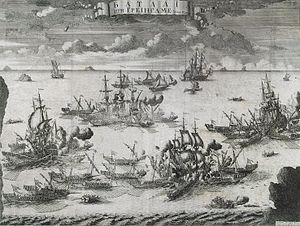Battle of Grengam
| Battle of Grengam | |||||||
|---|---|---|---|---|---|---|---|
| Part of Great Northern War | |||||||
 The Bringing of four Swedish frigates into St. Petersburg after the victory in the Battle of Grengam. | |||||||
| |||||||
| Belligerents | |||||||
|
|
| ||||||
| Commanders and leaders | |||||||
| Vice-Admiral Eric Sjöblad | Admiral Mikhail Galitzine | ||||||
| Strength | |||||||
|
Ship of the line 4 frigates 9 smaller craft over 1,000 sailors |
61 galleys 25 boats 11,000 sailors and soldiers | ||||||
| Casualties and losses | |||||||
|
103 killed, 407 taken prisoner | 82 killed and 236 wounded [1][2] | ||||||

The Battle of Grengam (Russian: Гренгамское морское сражение, Swedish: Slaget vid Granhamn) The Battle at the isle of Grengam (Granhamnsholm) between the flotilla of the Russian galley fleet and the Swedish sailing squadron on August 9 (July 27), 1720 was of great importance in the course of the Great Northern War. In the end of July 1720 Peter the First ordered the fleet (52 galleys and 15 boats with 52 guns and 11 000 troops ready for the deployment) under command of General M.M. Golitzin to reach Aland Islands in the Gulf of Bothnia. The goal of the operation was to force the Swedes out from the archipelago.
The Battle
The Swedish squadron under command of Vice-admiral K. Sjoblad (52-gun ship of the line, 4 frigates and 9 small crafts with 156 guns and over 1 000 marines) made an attempt to attack the Russians on route. Golitzin managed to take position of advantage in the narrow strait of Flisesund and ordered his ships in semicircle line. Swedish ship of the line and 4 frigates in a rush chasing of the Russian flotilla entered the strait where 2 frigates run aground therefore making maneuvers for the rest of the squadron difficult.
In the fierce fight that followed all the Swedish frigates were boarded. The only ship that managed to escape was Sjoblad’s flagship. The Swedes lost 103 killed and 407 captured, the Russians had 82 killed and 236 wounded. The Battle of Grengam demonstrated the skilful usage of rowing fleet in the skerries environment, efficient reconnaissance and selection of combat site, as well as perfect timing for the attack from different directions. The victory at Grengam allowed the Russians to consolidate in the archipelago that was very important to carry out the operations against the Swedish shipping in the area.
Aftermath
Four Swedish line-of-battle ships, the 34-gun frigate Stor Phoenix, the 30-gun Vainqueur, the 22-gun Kiskin and the 18-gun Danska Örn were captured by the Russian Navy. 43 out of 61 Russian galleys, were either sunk by the Swedish force (One ship-of-the-line, six frigates and some smaller crafts) or burnt and abandoned after the battle. The Swedish admiral Eric Siöblad was criticised after the battle.
Like the previous Battle of Gangut, the Battle of Grengam was fought on Saint Pantaleon Day. In order to commemorate the victory, a timber church to this saint was built in St. Petersburg in 1722. It was rebuilt in stone in 1735-39. The facade of the church bears (since 1914) two marble plaques listing the ships and regiments that fought at Gangut and Grengam.
References
Sources
- Wilson, Alastair, Callo, Joseph F., Who's who in Naval History: From 1550 to the Present, Routledge, 2004 ISBN 0415308283
- Morfill, William Richard, A History of Russia: From the Birth of Peter the Great to Nicholas II, James Pott Publisher, London, 1902
Recommended readings
- Template:Ru icon Great Soviet Encyclopedia. Grengam
- George Bruce. Harbottle's Dictionary of Battles. (Van Nostrand Reinhold, 1981) (ISBN 0-442-22336-6).
- Gunnar Unger (1923). Illustrerad svensk sjökrigshistoria, omfattande tiden 1680-1814. Stockholm: Albert Bonniers Förlag.
- Magnus Ullman, Rysshärjningarna på Ostkusten sommaren 1719
